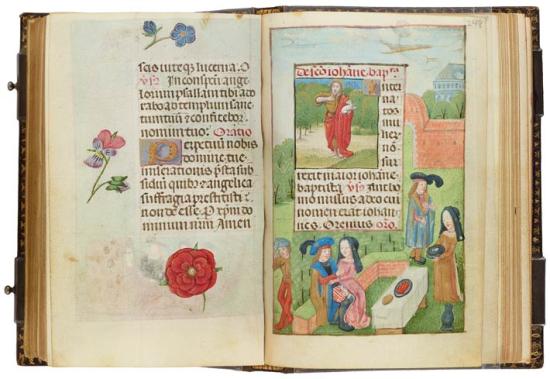
Book of Hours, in Latin
Bequest of E. Clark Stillman, 1995
In addition to the flowers strewn on most of its leaves, this tiny prayer book also contains numerous borders historiated with people dressed in contemporaneous clothing. The two foppishly dressed men shown here wear the new loose calf-length gown with wide lapels and long slit sleeves. Each man also wears two hats: a large wide-brimmed version, with an ostrich feather, worn atilt over a small cap. The seated youth wears the new stocks divided into lower and upper hose (here the upper hose — the boulevars — are striped). The women wear a new low-crowned coif with wide frontlet.
Twilight of the Middle Ages
This was a period of transition in northern Europe—the Middle Ages were not yet over, and the Renaissance had not yet begun. Both King Charles VIII and Louis XII invaded Italy, and these military campaigns exposed France to Italian art, culture, and fashion. At the same time, the Late Gothic style still dominated the arts—and clothing—of northern Europe. Fashions of this period reflect these conflicts.
In the 1480s, the look for men changed abruptly. Padded shoulders and the V-shaped silhouette disappeared. Long loose open gowns came into style and, by the 1490s, these gowns became especially voluminous and bulky. Round-toed shoes replaced the pointy pouleines. New, however, and probably reflecting Italian influence, were the man's outer coat called a sayon, the man's hat called a carmignolle, and doublets with slit sleeves through which the linen of the shirt protruded.
Women's gowns of this period also became fuller, and bombard sleeves were revived. The neck got square. The turret disappeared, while its frontlet remained, now attached to a new small-crowned coif.
